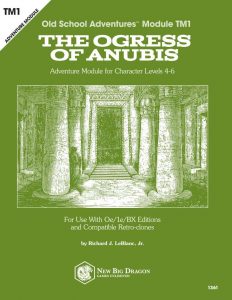The Ogress of Anubis (OSR)

This module clocks in at 20 pages, 1 page front cover, 1 page editorial, 1 page inside of front cover, 1 page SRD, 1 page inside of back cover, 1 page back cover, leaving us with 14 pages of content, so let’s take a look!
This module is intended for a group of characters level 4 – 6, with the suggested number of characters contingent on a) system chosen, and b) the skill of the players. This adventure, unlike most OSR-modules, does not simply subscribe to a single rule-set, nor does it provided barebones basic stats – one of its big advantages would be that the module truly covers 0e, 1e and B/X stats, noting discrepancies when applicable. This is not just a lip-service declaration, mind you – this extends to spells known, alignment notation, etc.
In light of this multi-system approach, magic items are bolded in the text, spells properly italicized, and the pdf does contain 12 sample pregens for your convenience. The module, apart from the introductory section to set the scene, does not feature read-aloud text, and comes with pretty detailed, nice b/w-maps. These maps do not come with player-friendly, unlabeled versions, but they do sport proper scales, excluding the small overland hex-map. On the plus-side, the pdf has a great bonus for guys like me – 5 different, player-friendly maps for tombs, 2 maps for sample caves, and one for a part of a sunken city are provided. These sample maps are genuinely cool and definitely make getting this worth if you like drawing maps as much as I do. (Read: Not at all.)
The pdf also sports a full page of hooks for further adventuring, and no less than 7 different types of animal mummies are provided, with stat notation correct for the systems covered. The pdf also features random monster tables for the overland section and the main adventure locale, differentiating between day and night, with different creatures to be encountered. The pdf also provides the stats for these, meaning you won’t have to engage in book-flipping. A definite plus! Speaking of which – the design-paradigm is ncie: While deadly snakes are included, their bite has a countdown to death instead of save-or-die, which allows the PCs to save their allies. Big plus for that! It’s simply more fun without neutering the threat or difficulty.
Speaking of which: This is not an easy module if your PCs are gung-ho and try to kill all opposition, but neither is it one of the harder OSR-modules out there.
The module, as evident from the title, takes place in a quasi-Egyptian setting. To talk about more details, I will have to go into SPOILERS. Potential players should jump ahead to the conclusion.
…
..
.
All right, only GMs around? Great! So, the module takes place in a mostly even plains-based area that features no less than 7 sample villages. Ako And Azibo, two villagers, beseech the PCs do something about Azeneth, the daughter of the recently-deceased high-priest of the temple of Ptah. Azeneth has proclaimed herself to be the chosen of the vulture goddess Nekhbet, and proceeded to extract heavy tithes from all around. Ostensibly able to command serpents, she rules by fear, not by love. Now, children have begun vanishing from the local towns, and rumors of human sacrifice abound – Azeneth must be stopped – which is easier said than done, for the fully mapped temple is now off-limits to all but her loyal guards, cult members and cherthebs – the low priests.
The temple and the small surrounding tent-city are properly noted, and I particularly enjoyed the reactions-tables provided for the respective types of servants. PCs attempting the brute force approach will have to shed a lot of blood, and probably be wiped out, but the reaction tables do a good job at supporting the obvious infiltration angle. Small pyramids containing animal mummies provide a nice risk-reward-ratio here; and the walled compound itself is actually also guarded by living statues, some of which are watching from the temple’s roof…
All of this is very much a sandbox – a problem is provided, and how your PCs get to solve it? That’s totally up to them.
Conclusion:
Editing and formatting are top-notch on a formal and rules-language level. Layout adheres to a no-frills b/w-2-column standard, and the pdf uses public domain art to a surprisingly good effect. The cartography in b/w is solid and more detailed than I expected – and while the lack of player-friendly, unlabeled versions is a bit of a bummer, the inclusion of player-friendly bonus maps is a nice plus. The pdf has no bookmarks, which is a slight comfort detriment.
Richard J. LeBlanc Jr.’s “Ogress of Anubis” doesn’t reinvent the wheel – this is essentially a go-play easy to use module that is nigh perfect for the instances when you need a module, but don’t have one prepared. You can basically run this as is with minimum fuss, also thanks to the attention to detail regarding the systems supported. This is not a mind-blowing adventure, but a solid, unpretentious sidetrek I’d usually rate somewhere in the vicinity of 3.5 stars, rounded down. However, this is actually FREE. Not even PWYW, FREE. And for a FREE module? Heck yes, totally worth downloading! My final verdict hence will clock in at 3.5 stars, rounded up.
You can get this adventure for FREE here on OBS!
Want it in print? You can find that version here on lulu!

Endzeitgeist out.
